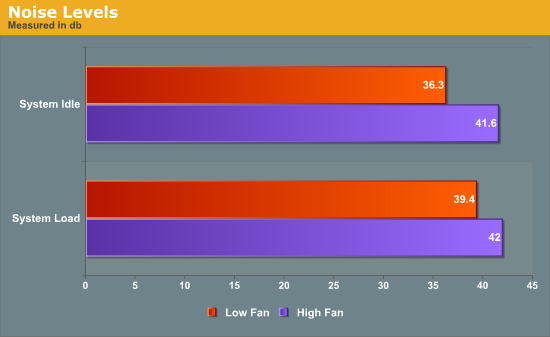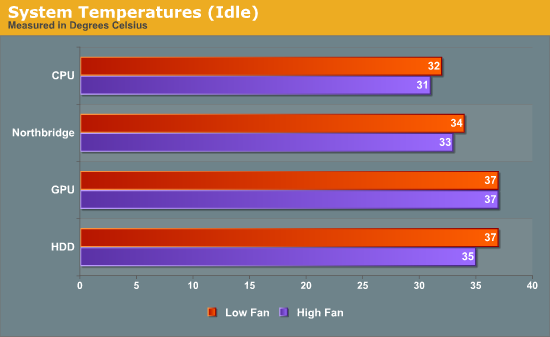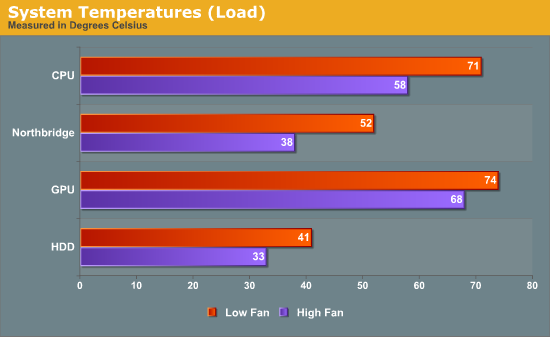SilverStone GD04 HTPC Case: Cool, Not Quiet
by Dustin Sklavos on December 25, 2010 12:00 AM EST- Posted in
- Cases/Cooling/PSUs
- HTPC
- SilverStone
- GD04
Thermal and Noise Testing
In testing the SilverStone GD04, I actually added components you're not going to see in the gallery but wound up needing just to keep the noise level down: the Zalman CNPS7000, which with the included FanMate controller was kept running at a low setting, and a Xigmatek Mono-Cool fan controller, the only controller I could find on NewEgg that fit into an expansion slot instead of a drive bay. The Xigmatek controller has headers for three fans, making it seem perfectly tailored to this task. Noise was measured using an Extech SL10 sound meter, while temperatures were measured conventionally using HWMonitor. The test system specs are as follows:
| Test Configuration | |
| CPU | AMD Athlon II X4 640 |
| Motherboard | ASUS M4A78LT-M AM3 MicroATX |
| Graphics Card | EVGA GeForce GTS 450 |
| Memory | 2x2GB DDR3-1333 |
| Drives |
LG HD-DVD/Blu-ray/DVDRW Combo Drive 1x Western Digital Caviar Blue 640GB |
| CPU Cooler | Zalman CNPS7000 |
| Power Supply | PC Power & Cooling 500W |
These aren't loud components to begin with, but remember: this is a media center case with three 120mm fans, and at least in my apartment it's going to be out in the open. Silence is paramount for a build like this. To generate load temperatures and noise, I ran 3DMark06 in a loop with Prime95 in the background and left it running for fifteen minutes at a time. The system was tested with the fan controller at its lowest and highest settings, and the sound meter was positioned one foot away from the tower, on a tripod, pointed directly at the side of the case.

While the fan noise wouldn't be a major issue for a normal PC that's probably going to be hidden under or near a desk, a media center PC really does need to run quieter than this. The first time I powered it up I was actually alarmed at how loud it was, and even though the character of the noise is a low whooshing, it's nonetheless very audible. Not good. So how are the thermals, then?


Thermals are actually pretty decent; remember this is a heavy artificial load being placed on the system. With the fans running at full bore everything's actually pretty good, but at low speed the processor's temperature becomes a bit worrying. Odds are good in actual use the CPU won't get this hot, but it's still not ideal. The idle temperatures are excellent at least.










68 Comments
View All Comments
Alexvrb - Saturday, December 25, 2010 - link
Actually I thought he brought up some valid concerns. If you're going to bother testing an HTPC setup, do it right. Maybe he went a little overboard, but he still makes some good points. For one, I'd rather know how loud and what pitch it makes from the front. It's an HTPC, it's gonna sit on a shelf and directly face you.JarredWalton - Sunday, December 26, 2010 - link
I understand what some of you are getting at, but I think you're missing the point here. We are reviewing a case, and we are not trying to make a silent system. That might be something for another article, but this is a review of a case as-is, which means using what they provided. The noise levels were bad enough that Dustin bought a fan control unit, but the goal wasn't to create the ultimate silent PC.I've asked Dustin to update the article with additional details on the testing environment and equipment, so that will probably happen after the Christmas weekend. Again, however, we're starting out with some new case reviews and Dustin has a testbed he'll be using. I'm not sure an anechoic chamber with higher sensitivity equipment is all that useful considering I've had plenty of PSUs that apparently rate "20dB" where I can easily hear them in a normal system. Anyway, give Dustin a chance to put together a few reviews and we'll hopefully establish the testing environment so that the comparison point is clear.
RobertR13 - Sunday, December 26, 2010 - link
Can we get him to either use the same internals or test the cases without any internals with just the power supply being jumped, and with the same power supply for every test, so we can at least compare results from one test to another?I would be perfectly happy without a sound box, so long as the noise floor is listed at the time of testing.
Thanks Jarred.
Belard - Tuesday, December 28, 2010 - link
When it comes to PSUs, they could use a fanless PSU model for noise testing alone.The review with the stock FANs are valid, but it should be shown that using better fans/controls can fix it. For $100 - its a rather high end case at a low-cost price so Silverstone went with crap fans... when they might as well gone with none.
micksh - Sunday, December 26, 2010 - link
The article title has "not quiet" in it.It will never be quiet until you choose right components.
The title looks like it's the case to blame but in fact it was selection of components. No HTPC case will silence vacuum cleaners or airplane jet engines you put in it.
"this is a review of a case as-is, which means using what they provided"
Case fans as they provided as-is were quieter or louder than power supply, for example? The article doesn't tell even that. Why?
"We are reviewing a case, and we are not trying to make a silent system"
Not even trying to make it silent?
What is the point of loud system in living room when someone wants to watch movies?
"but the goal wasn't to create the ultimate silent PC."
Understood, but it has to be reasonably quiet in order to be used as HTPC.
Otherwise, what's the point?
You can just turn on head dryer in background and see what effect it has on viewers.
Was your system louder or quieter than head dryer? Need comparison measurements.
Practical value of this review is what? This case works, here are photos, it can be done, we proved it, it's like your any other HTPC case, but we don't know anything else. Did I miss anything?
JarredWalton - Monday, December 27, 2010 - link
Obviously the case fans are a major noise contributor, considering that adding a fan control unit to slow them down dropped total noise from 41.6dB down to 36.3dB. The question is how much of the remaining noise is from the PSU, GPU, CPU, etc. Fanless components would be ideal for the other areas, but fanless generally means slower (or exotic cooling) so you can't always go that route without becoming a skewed look at cooling, noise, and performance.The Athlon II X4 640 certainly isn't the lowest power CPU on the market, but it also doesn't draw a ton of power. The GTS 450 is in the same boat. These are mainstream parts good for a look at the "typical" experience.
The fact of the matter is that this is an HTPC case, and a major source of noise is the fans. However, I'd also say that running three 120mm fans in most cases is overkill. I'll discuss some ideas with Anand and Dustin to improve the overall approach; the major issue right now I think is that while AnandTech in general has a ton of hardware at our disposal, Dustin doesn't have all that much.
Perhaps what will be best is a two-pronged review approach where we have a "lower power/noise" testbed as well as a higher end configuration, and using both we can provide a look at a range of performance options with each case... but putting together two systems for each case review can be a pain. I think Robert's suggestion above about testing with no hardware other than the case fans also has merit, though we'd need some sort of PSU to do that. There are hybrid models where the fans don't spin until at least a ~300W load that we could use for such testing.
Anyway, we'll be looking at feedback and working to improve the case reviews, but I'm not sure how long it will take to sort things out. Stay tuned....
RobertR13 - Monday, December 27, 2010 - link
While most of those points are vague and refutable at best, they're all completely besides the point. If you're going to advertise an article as a case review based on the case, "as-is" you can't stuff it with a bunch of random hardware, publish a bunch of pretty numbers that you can't compare to anything, and call it objective. That is my entire point.For PSU, there are a LOT of completely fanless options, and passive means essentially no noise. Grab a PicoPSU, up to 150W, jump the ATX connector with the fans attached and you will have an idea of what the case sounds like empty.
Or if he can wire a little bit, grab a $5 12v inverter from Walmart or Radioshack, cut off the end, wire on a molex plug and use a Y adapter to power just the fans. I even have one here, I could clean up, heatshrink and send out, I found it at Fry's electronics and allows you to manually set the voltage at about six different levels, four of them up to 12V, so you can even test the stock fan sound levels at different voltages as though they were on a switched fan controller.
micksh - Monday, December 27, 2010 - link
I think they at Anandtech understand it now.No need to go completely fanless as this would limit your PC too much. There is a lot of stuff that you can't do with 150W PicoPSU.
This is HTPC. For good HD image quality you need some image enchancement that video card does. Low powered video cards just can't do that.
See this: http://www.anandtech.com/show/3973/nvidias-geforce...
There are also video quality reviews from other sites like xbitlabs.com. They show that realistically, around 70W or more TDP video card is required for better video quality. Then there is 65-73W for CPU for smooth experience, then chipset, storage, etc... Then if you think of future proof design 150W PicoPSU should be out of question.
It may change when/if Sandy Bridge graphics proves that it's good enough for HTPC but we are not there yet.
Yes, there are passive PSUs with 400 and more watts of power. But they don't dominate on the market for some reasons. I think it should be a subject for a different discussion.
My opinion is why limit yourself when you can have quiet system with lots of power and quiet fans?
micksh - Monday, December 27, 2010 - link
"Obviously the case fans are a major noise contributor, considering that adding a fan control unit to slow them down dropped total noise from 41.6dB down to 36.3dB."Yes, that sounds obvious but then during load noise levels quickly jumped to 39.4 dB with low fans. Noise contribution from different components can be quite complex. And it depends on position where you measure noise. Yes, case fans seem to be the worst guys. But next obvious step to me would be to stop them one by one with fingers and to verify where the noise is coming from.
"The GTS 450 is in the same boat"
I think you are oversimplifying here. There is no just GTS 450 card. There are different GTS 450 models from different vendors. The amount of noise these models produce may vary from inaudible to intolerable. With price difference like $10 between them. I don't know about your EVGA card.
Thanks, I see that you are on the right track. Will stay tuned.
Besides, Anand himself didn't show pictures of his home theater setup for a while. What HTPC is he using? From the pictures that I saw I don't think he had to make compromises that would result suffering from loud HTPC.
RobertR13 - Sunday, December 26, 2010 - link
I don't see why you have to result to insults and name-calling, but so be it. I don't see why being annoyed that a test being presented as fact, while being completely subjective is petulant or childish, but sure, whatever makes your christmas better.1: There are no other Case testers at Anandtech anymore. The last series of case tests we saw ended in February of 2009, using different internals and at a different location, without any testing methodologies being reported. This is the second article by this author, and while his testing methodology is similar, the internal components are completely different, making the results completely non-comparable.
2: Fair enough. It's completely non-real world, but sure, it would be fine if it were just being used as a reference point to compare cases, but we can't compare results between this and any other article.
3: Noise is additive actually, both in frequency and decibels, that's why other testers here at anandtech use a soundbox for testing power supplies.
4: Again with the insults, you couldn't just refute the point or skip over it?